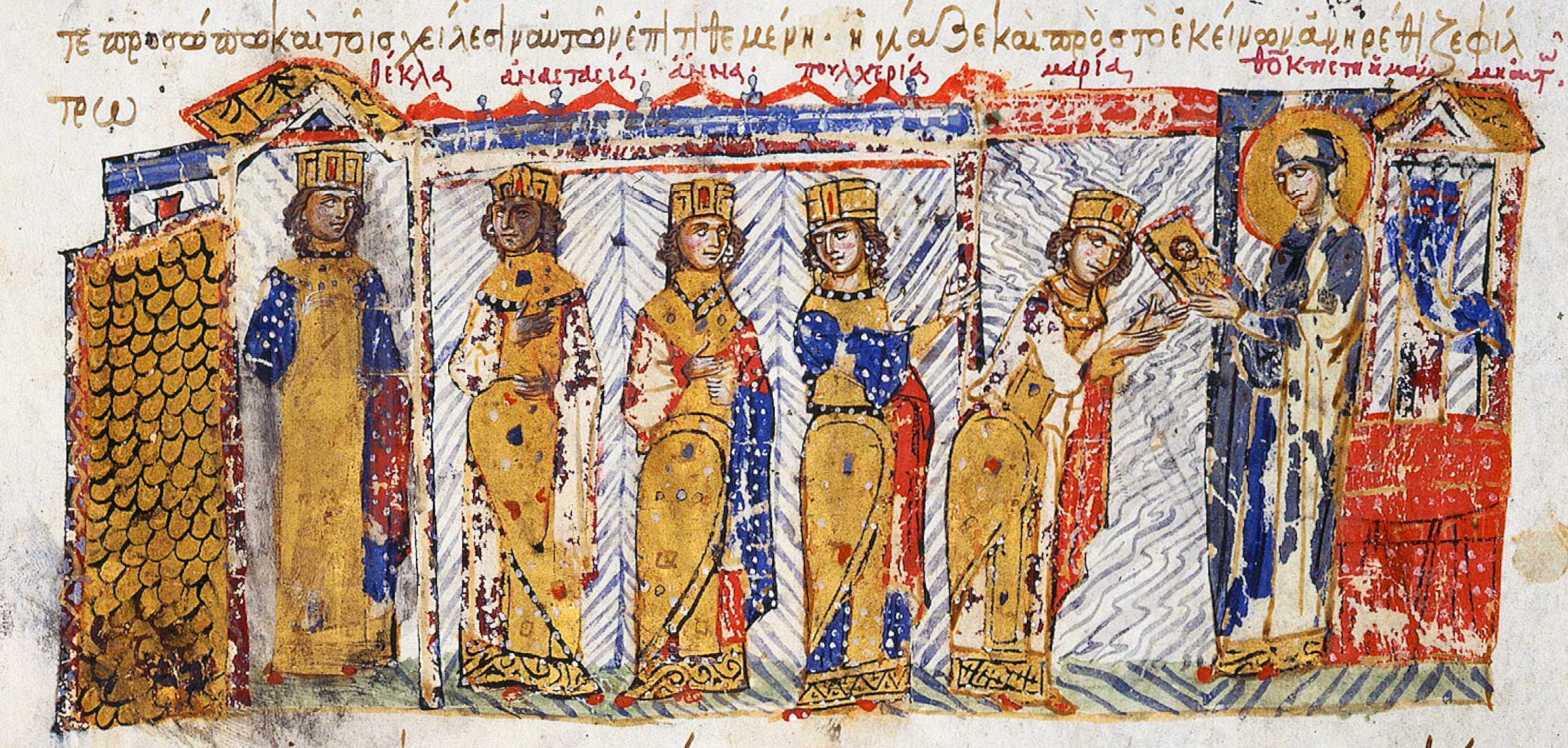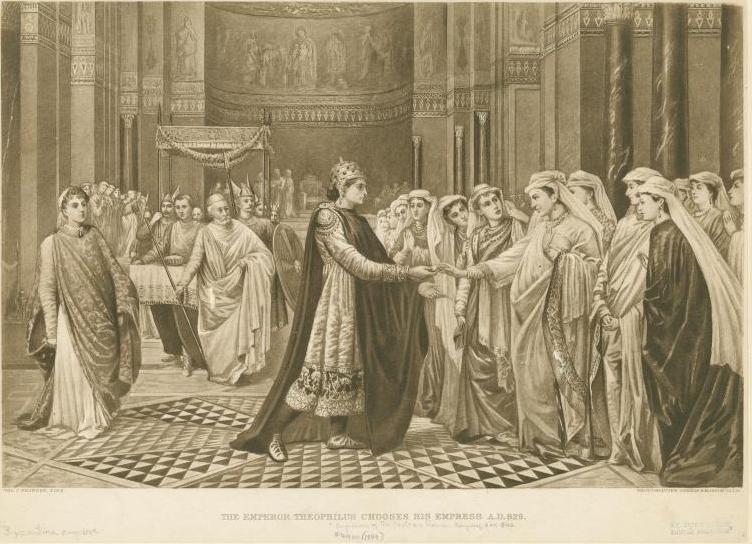|
Theoktiste
Theoktiste ( el, Θεοκτίστη), also known as Phlorina (Φλώρινα), was the mother of the 9th-century Byzantine empress Theodora, the wife of Emperor Theophilos. Life Theoktiste Phlorina was the spouse of Marinos, an officer in the Byzantine army with the rank of ''tourmarches'' or ''droungarios''. The family originally lived in, or hailed from, the town of Ebissa in Paphlagonia. Some modern genealogists, including Cyril Toumanoff and Nicholas Adontz, have suggested that Marinos hailed from the Armenian noble clan of the Mamikonian. According to Nina Garsoïan in the ''Oxford Dictionary of Byzantium'', however, " tractive though it is, this thesis cannot be proven for want of sources." With Marinos, Theoktiste had two sons, Bardas and Petronas, and four daughters, Theodora, Sophia, Maria and Irene. In 821 or 830 (the date is disputed), Theodora married Theophilos, who in 829 succeeded his father Michael II the Amorian (ruled 820–829) as emperor. With her daughter's ... [...More Info...] [...Related Items...] OR: [Wikipedia] [Google] [Baidu] |
Theodora (wife Of Theophilos)
Theodora (Greek language, Greek: Θεοδώρα; 815 – c. 867), sometimes called Theodora the Armenian or Theodora the Blessed, was Byzantine empress as the wife of Byzantine emperor Theophilos (emperor), Theophilos from 830 to 842 and regent for the couple's young son Michael III, after the death of Theophilos, from 842 to 856. She is sometimes counted as an empress regnant, who actually ruled in her own right, rather than just a regent. Theodora is most famous for bringing an end to the second Byzantine Iconoclasm (814–843), an act for which she is recognized as a saint in the Eastern Orthodox Church. Though her reign saw the loss of most of Sicily and failure to retake Crete, Theodora's foreign policy was otherwise highly successful; by 856, the Byzantine Empire had gained the upper hand over both First Bulgarian Empire, Bulgaria and the Abbasid Caliphate, and the Slavs, Slavic tribes in the Peloponnese had been forced to pay tribute, all without decreasing the imperial g ... [...More Info...] [...Related Items...] OR: [Wikipedia] [Google] [Baidu] |
Zoste Patrikia
''Zōstē patrikía'' ( gr, ζωστὴ πατρικία) was a Byzantine court title reserved exclusively for the woman who was the chief attendant and assistant to the Empress. A very high title, its holder ranked as the first woman after the Empress herself in the imperial court. The title is attested from the 9th century until the 12th century, but only a handful of its holders are known. History The title means "girded lady-patrician", often translated into English as "Mistress of the Robes", and was used for high-ranking court ladies who were attached to the Byzantine empresses as their ladies of honour. Its origin or date of institution are unclear. Disregarding a clearly anachronistic reference to Antonina, the wife of the great 6th-century general Belisarius, as being a ''zostē patrikia'', the title is first attested in for Theoktiste, the mother of Empress Theodora. The title is last attested in literary sources (the ''Skylitzes Chronicle'') in 1018, when it was conf ... [...More Info...] [...Related Items...] OR: [Wikipedia] [Google] [Baidu] |
Gastria Monastery
Sancaktar Hayrettin Mosque ( tr, Sancaktar Hayrettin Câmîi; also ''Sancaktar Hayrettin Mescidi'', where ''Mescit'' is the Turkish word for a small mosque, or ''Sancaktar Mescidi'') is part of a former Eastern Orthodox monastery converted into a mosque by the Ottomans. It is generally believed that the small building belonged to the Byzantine Monastery of Gastria ( el, , ''Monē tōn Gastríōn'', meaning "Monastery of the Vases"). The edifice is a minor example of Palaiologan architecture in Constantinople, and is important for historical reasons. Location The medieval structure, choked by artisan shops, lies in Istanbul, in the district of Fatih, in the neighborhood of Kocamustafapaşa (historically Samatya), on ''Teberdar Sokak'', about five hundred meters north east of the Kocamustafapaşa station of the suburban railway line between Sirkeci and Halkalı. History The origin of this building, which lies on the southern slope of the seventh hill of Constantinople and overl ... [...More Info...] [...Related Items...] OR: [Wikipedia] [Google] [Baidu] |
Petronas (general)
Petronas ( el, ; died November 11, 865) was a notable Byzantine general and leading aristocrat during the mid-9th century. Petronas was a brother of Empress Theodora and hence brother-in-law of Emperor Theophilos, under whom he advanced to the rank of ''patrikios'' and the post of ''droungarios'' of the '' Vigla'' regiment. After Theophilos' death, he played a role in the ending of Iconoclasm, but was sidelined along with his brother Bardas during the minority of his nephew, Michael III, when power was held by the regent Theoktistos. In 855, Petronas and Bardas encouraged Michael III to seize control of the government: Theoktistos was murdered, Theodora banished to a monastery, Bardas became Michael's chief minister, and Petronas was tasked with the war against the Arabs. In 863, he scored a crushing victory at the Battle of Lalakaon, a feat which marked the gradual beginning of a Byzantine counter-offensive in the East. Promoted to ''magistros'' and ''domestikos ton scholon'', ... [...More Info...] [...Related Items...] OR: [Wikipedia] [Google] [Baidu] |
Bardas
Bardas ( el, Βάρδας; died 21 April 866) was a Byzantine Empire, Byzantine noble and high-ranking minister. As the brother of Empress Theodora (wife of Theophilos), Theodora, he rose to high office under Theophilos (emperor), Theophilos (. Although sidelined after Theophilos's death by Theodora and Theoktistos, in 855 he engineered Theoktistos's murder and became the ''de facto'' regent for his nephew, Michael III (). Rising to the rank of ''Caesar (title), Caesar'', he was the effective ruler of the Byzantine Empire for ten years, a period which saw military success, renewed diplomatic and missionary activity, and an intellectual revival that heralded the Macedonian Renaissance. He was assassinated in 866 at the instigation of Michael III's new favourite, Basil the Macedonian, who a year later would usurp the throne for himself and install Macedonian dynasty, his own dynasty on the Byzantine throne. Biography Early life Bardas was born to the ''droungarios'' Marinos and The ... [...More Info...] [...Related Items...] OR: [Wikipedia] [Google] [Baidu] |
Iconodule
Iconodulism (also iconoduly or iconodulia) designates the religious service to icons (kissing and honourable veneration, incense, and candlelight). The term comes from Neoclassical Greek εἰκονόδουλος (''eikonodoulos'') (from el, εἰκόνα – ''icon (image)'' + el, δοῦλος – ''servant''), meaning "one who serves images (icons)". It is also referred to as iconophilism (also iconophily or iconophilia from el, εἰκόνα – ''icon (image)'' + el, φιλέω – ''love'') designating a positive attitude towards the religious use of icons. In the history of Christianity, iconodulism (or iconophilism) was manifested as a moderate position, between two extremes: iconoclasm (radical opposition to the use of icons) and iconolatry (idolatric veritable (full) adoration of icons). History In contrast to moderate or respectful adoration, various forms of latria of icons (''iconolatry'') were also starting to appear, mainly in popular worship. Since verita ... [...More Info...] [...Related Items...] OR: [Wikipedia] [Google] [Baidu] |
Patrikios
The patricians (from la, patricius, Greek: πατρίκιος) were originally a group of ruling class families in ancient Rome. The distinction was highly significant in the Roman Kingdom, and the early Republic, but its relevance waned after the Conflict of the Orders (494 BC to 287 BC). By the time of the late Republic and Empire, membership in the patriciate was of only nominal significance. The social structure of Ancient Rome revolved around the distinction between the patricians and the plebeians. The status of patricians gave them more political power than the plebeians. The relationship between the patricians and the plebeians eventually caused the Conflict of the Orders. This time period resulted in changing the social structure of Ancient Rome. After the Western Empire fell, the term "patrician" continued as a high honorary title in the Eastern Empire. In the Holy Roman Empire and in many medieval Italian republics, medieval patrician classes were once again formal ... [...More Info...] [...Related Items...] OR: [Wikipedia] [Google] [Baidu] |
Byzantine Iconoclasm
The Byzantine Iconoclasm ( gr, Εικονομαχία, Eikonomachía, lit=image struggle', 'war on icons) were two periods in the history of the Byzantine Empire when the use of religious images or icons was opposed by religious and imperial authorities within the Orthodox Church and the temporal imperial hierarchy. The First Iconoclasm, as it is sometimes called, occurred between about 726 and 787, while the Second Iconoclasm occurred between 814 and 842. According to the traditional view, Byzantine Iconoclasm was started by a ban on religious images promulgated by the Byzantine Emperor Leo III the Isaurian, and continued under his successors. It was accompanied by widespread destruction of religious images and persecution of supporters of the veneration of images. The Papacy remained firmly in support of the use of religious images throughout the period, and the whole episode widened the growing divergence between the Byzantine and Carolingian traditions in what was still ... [...More Info...] [...Related Items...] OR: [Wikipedia] [Google] [Baidu] |
Icon
An icon () is a religious work of art, most commonly a painting, in the cultures of the Eastern Orthodox, Oriental Orthodox, and Catholic churches. They are not simply artworks; "an icon is a sacred image used in religious devotion". The most common subjects include Christ, Mary, saints and angels. Although especially associated with portrait-style images concentrating on one or two main figures, the term also covers most religious images in a variety of artistic media produced by Eastern Christianity, including narrative scenes, usually from the Bible or the lives of saints. Icons are most commonly painted on wood panels with egg tempera, but they may also be cast in metal, carved in stone, embroidered on cloth, done in mosaic or fresco work, printed on paper or metal, etc. Comparable images from Western Christianity can be classified as "icons", although "iconic" may also be used to describe a static style of devotional image. In the Greek language, the term for icon paintin ... [...More Info...] [...Related Items...] OR: [Wikipedia] [Google] [Baidu] |
Michael III
Michael III ( grc-gre, Μιχαήλ; 9 January 840 – 24 September 867), also known as Michael the Drunkard, was Byzantine Emperor from 842 to 867. Michael III was the third and traditionally last member of the Amorian (or Phrygian) dynasty. He was given the disparaging epithet ''the Drunkard'' () by the hostile historians of the succeeding Macedonian dynasty, but modern historical research has rehabilitated his reputation to some extent, demonstrating the vital role his reign played in the resurgence of Byzantine power in the 9th century. He was also the youngest person to bear the imperial title, as well as the youngest to succeed as senior emperor. Life Early life and regency Michael was the youngest child of the emperor Theophilos and his empress Theodora. His precise date of birth is uncertain, but the balance of available evidence supports a birthdate in early 840, probably on 9 or 10 January. He was crowned co-emperor soon after, probably on 16 May of the same year ... [...More Info...] [...Related Items...] OR: [Wikipedia] [Google] [Baidu] |










